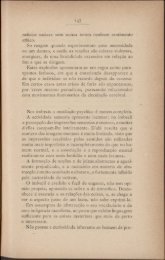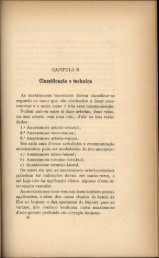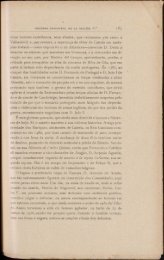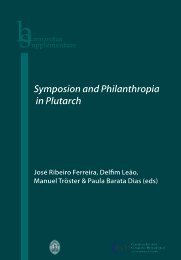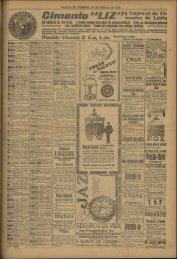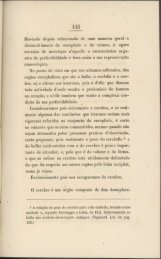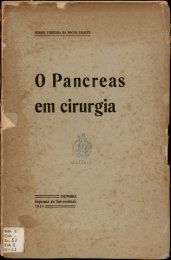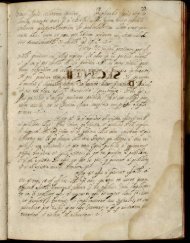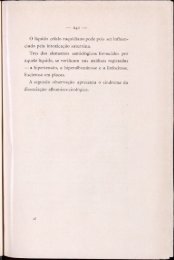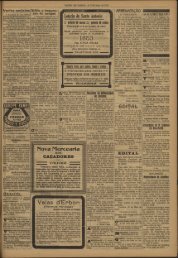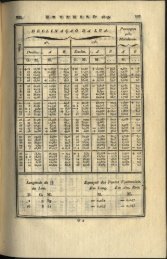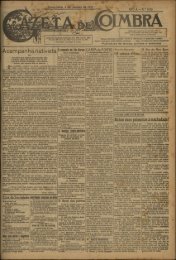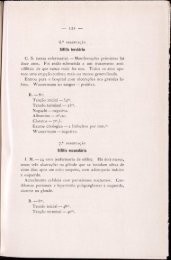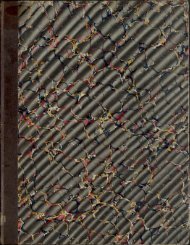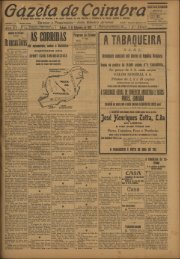The Lyric Metres of Euripidean Drama - Universidade de Coimbra
The Lyric Metres of Euripidean Drama - Universidade de Coimbra
The Lyric Metres of Euripidean Drama - Universidade de Coimbra
Create successful ePaper yourself
Turn your PDF publications into a flip-book with our unique Google optimized e-Paper software.
Trochaic<br />
iambic. 61 <strong>The</strong>oretically, it would be possible to distinguish between ‘iambic’<br />
(acatalectic) and ‘trochaic’ (catalectic) lecythia. But there is possibly little<br />
tangible gain in such a distinction. Euripi<strong>de</strong>s and Sophocles <strong>of</strong>ten use the<br />
‘iambic’ lecythion with a clausular effect to mark the end <strong>of</strong> a metrical period; 62<br />
this would suggest that, even in otherwise non-trochaic contexts, it soun<strong>de</strong>d<br />
somehow intrinsically catalectic (cf. its repeated clausular use in a polymetric<br />
— admittedly partly trochaic — lyric context at Ba. 579, 584, 588, 589, 593,<br />
603). Another important fact which further reinforces its catalectic status is<br />
the avoidance <strong>of</strong> word overlap between a lecythion and the following colon.<br />
This is a striking feature in Euripi<strong>de</strong>s and Sophocles, 63 though (interestingly<br />
enough) not in Aeschylus. 64 A lecythion ending with an eli<strong>de</strong>d word is also<br />
rare: I have found only three instances in Euripi<strong>de</strong>s (Andr. 142, Tr. 830, Rh.<br />
825) and none in Sophocles (Aeschylean practice is irrelevant here, since he<br />
uses lecythia in synartesis).<br />
It would seem, then, that the trochaic label has the stronger theoretical<br />
claim, even in iambic contexts where the lecythion would be the only ostensibly<br />
trochaic element. But perhaps it would be preferable to view the lecythion as<br />
a genuinely ambiguous rhythm, poised half way between iambic and trochaic,<br />
and the i<strong>de</strong>al gleiten<strong>de</strong>r Übergang, therefore, for effecting a transition from one<br />
rhythm to the other. Owing to the scarcity <strong>of</strong> lyric trochees in extant tragedy,<br />
however, we find that instances <strong>of</strong> the lecythion as a transitional phrase from<br />
iambic to trochaic are rare: see Su. 368a~372a, Tr. 830~849, Hel. 235-7 and<br />
IA 1481-2. Trochaic to iambic: Herc. 386~400, Ph. 1719-21, IA 1315, Phaeth.<br />
100. 65 A lecythion follows a run <strong>of</strong> cretics at Ph. 317.<br />
Occasionally, the lecythion provi<strong>de</strong>s the means for modulating into iambic<br />
(or trochaic) from another rhythm and vice versa:<br />
61 For lecythia as iambic, see Korzeniewski ( 2 1989: 4). Fraenkel, it would seem, viewed<br />
lecythia as essentially trochaic (comm. Ag., vol. II, pp. 59 and 327).<br />
62 Cf. Alc. 214b~227b, Hi. 1386, Andr. 276~286, 1210~1223, Hec. 706, Su. 366~370, El. 153,<br />
480, Herc. 412, Tr. 1093~1111, IT 867, Ion 1476, Ph. 317, 1750, S. Ai. 868, 871 (|| B ), El. 208<br />
(|| B )~228 (|| H ), 855~866, OT 199~212, 884~898, 886~900, 888~902, 1338 (|| B )~1358, Trach.<br />
222, Ant. 1139~1148 (|| B ), Phil. 1171, 1212 (|| B ), OC 209, 1563 (|| B )~1575 (|| H ).<br />
63 <strong>The</strong>re is a Sophoclean exception at Trach. 133 with the divisions favoured by Dawe as well<br />
as Lloyd-Jones and Wilson, but I would sooner follow Jebb in diving ‘ia + cr | 2 tr | lk’.<br />
64 <strong>The</strong>re are two doubtful instances in Diggle’s OCT: Andr. 484~492, avoidable with<br />
Willink’s alternative colometry (cf. 2010: 227 n. 17; and n. 70 below); Or. 1370, also avoidable<br />
(see Willink’s comm. ad loc.). <strong>The</strong>re appear to be no lecythia in synartesis with the following<br />
colon in Sophocles, who seems to have regar<strong>de</strong>d it as a ‘sentence-ending’ rhythm. In Aeschylus,<br />
however, we find dovetailed lecythia at Su. 1062-3~1068-9; Ag. 442-4~461-3, 681-3~699-701;<br />
Ch. 607~617; Eum. 494~503, 497~506, 515~524, 782~812.<br />
65 Parker (1990: 331 n. 1) <strong>of</strong>fers a shorter list <strong>of</strong> examples from Euripi<strong>de</strong>s. She rightly draws<br />
attention to the fact that the lecythion as a transitional phrase is an important metrical feature<br />
<strong>of</strong> the Frogs’ Boating Song (cf. also 1997: 456-67). See also Morais (1995).<br />
41



